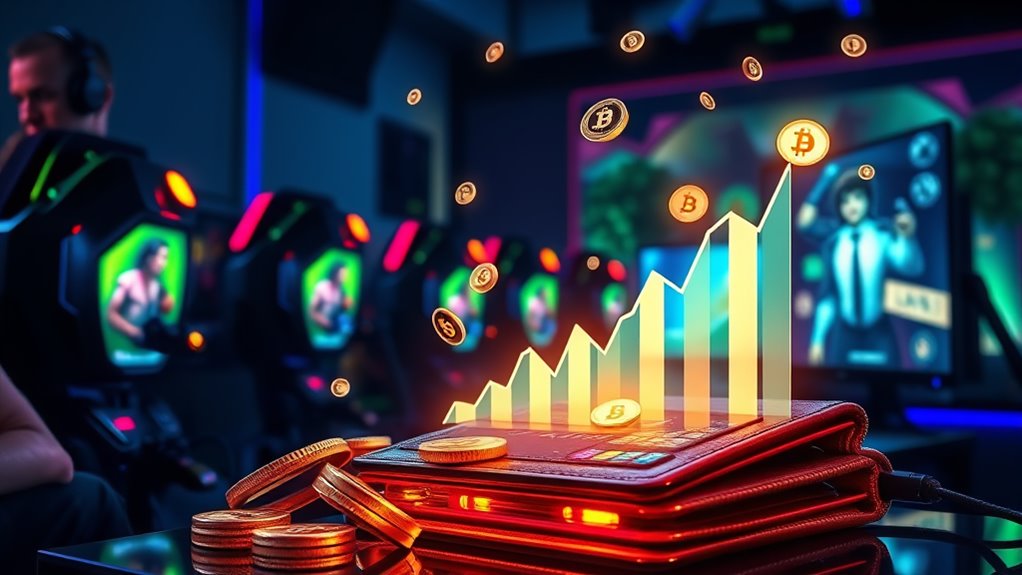
Play-to-Earn Games: How to Profit in Blockchain Gaming?
Play-to-earn games utilize blockchain technology to create earning opportunities for players. Users can profit by completing in-game tasks, participating in battles, and trading non-fungible tokens (NFTs). In-game currencies and assets can be exchanged for cryptocurrencies with real-world value. Passive income can also be generated through staking and yield farming. A clear understanding of in-game economies and strategic asset management enhances earning potential. Exploring these elements reveals more about how to maximize earnings in this evolving landscape.
Key Takeaways
- Engage in daily quests and challenges to consistently earn rewards in the form of cryptocurrencies and NFTs.
- Trade and sell in-game assets and NFTs on marketplaces to realize real-world value from your earnings.
- Participate in PvP tournaments and ranked matches to showcase skills and earn higher-value rewards.
- Utilize staking and yield farming to generate passive income by locking up tokens and providing liquidity.
- Stay informed about market trends and adjust strategies to maximize earnings from digital asset trading.
Understanding Play-to-Earn Games and Blockchain Technology

Play-to-Earn (P2E) games represent a significant shift in the gaming landscape, integrating blockchain technology to create new economic opportunities for players.
These games allow individuals to earn rewards by completing tasks, winning battles, or engaging in the game’s virtual economy. Blockchain guarantees transparency and security, providing players with ownership of their in-game assets, which can include cryptocurrencies, tokens, or valuable virtual items.
Players can earn rewards through gameplay, enjoying true ownership of their assets thanks to blockchain’s transparency and security.
The decentralized nature of these games fosters unique economies where players can freely trade their rewards. Community engagement plays an essential role in the success and longevity of P2E games, as active communities often indicate a game’s viability.
This innovative approach transforms traditional gaming by adding financial incentives and encouraging broader participation.
The Role of Non-Fungible Tokens in Gaming

The emergence of Non-Fungible Tokens (NFTs) has significantly influenced the landscape of gaming, particularly within the Play-to-Earn model.
NFTs empower players by providing true ownership of in-game assets, unlike traditional models where developers retain control. Each asset’s ownership and transaction history are securely recorded on a blockchain, ensuring transparency.
These tokens can be utilized across different games and platforms, enhancing their value and utility. Players can trade or sell NFTs in various marketplaces, creating potential profit opportunities.
Additionally, NFTs contribute to in-game advantages, making them more desirable. Their integration into gameplay mechanics fosters player engagement and creativity, illustrating the significant role NFTs play in shaping modern gaming experiences.
Exploring In-Game Economies and Profit Opportunities

In the domain of play-to-earn games, understanding in-game currencies is essential for players looking to maximize their profit opportunities.
These digital currencies enable trading of assets, allowing players to engage in transactions that can yield real-world value.
Additionally, earning through challenges not only enhances gameplay but also provides avenues for financial gain, making the in-game economy a pivotal aspect of this gaming model.
Understanding In-Game Currencies
In-game currencies have revolutionized the landscape of gaming, particularly through the rise of blockchain technology. These currencies support diverse monetization models, allowing players to earn and trade cryptocurrencies and NFTs. Players benefit from decentralized ownership of their assets, unlike traditional gaming models. The following table outlines different types of in-game currencies and their characteristics:
| Currency Type | Characteristics | Example Uses |
|---|---|---|
| Cryptocurrencies | Rewards for achievements, exchangeable | Completing quests |
| NFTs | Unique digital items, valuable due to scarcity | Selling on marketplaces |
| Native Tokens | Specific to each game, used in its ecosystem | Purchasing items |
| Token Values | Fluctuate based on market demand | Participating in governance |
Understanding these currencies is essential for grasping their profit potential in blockchain gaming.
Trading Digital Assets
Trading digital assets in the domain of blockchain gaming has emerged as a significant aspect of the gaming economy. In-game items minted as NFTs grant players true ownership, enabling them to trade and monetize their assets, thereby creating real-world value.
Decentralized marketplaces allow trading outside the game ecosystem, opening diverse profit opportunities. Players can convert NFTs into cryptocurrencies, providing a tangible income source. Transactions are secured through blockchain technology, enhancing transparency and reducing risks typically associated with traditional gaming assets.
However, challenges remain, particularly regarding interoperability, as transferring assets between different games is not yet seamless. Nevertheless, the potential for growth in the trading of digital assets continues to attract players and investors alike. Additionally, players must be aware of their tax obligations when trading these assets, as cryptocurrency transactions can trigger capital gains tax.
Earning Through Challenges
Earning rewards in play-to-earn games is primarily achieved through various challenges that players undertake, which greatly contribute to the in-game economy.
Players can complete quests to earn cryptocurrencies or NFTs, while participating in PvP battles and tournaments can yield additional rewards. Daily quests provide consistent opportunities for earning, encouraging ongoing engagement.
Additionally, defeating powerful bosses may offer high-value prizes, enhancing the thrill of gameplay. Staking mechanisms allow players to earn passive income from their assets.
The in-game economy thrives through decentralized markets where players can buy and sell items, and resource gathering plays an essential role in crafting valuable assets.
Earning Through Quests, Battles, and Tournaments

In play-to-earn (P2E) games, players can earn rewards by completing in-game challenges and participating in player-versus-player (PvP) tournaments.
These activities often yield cryptocurrencies or unique in-game assets, enhancing the gaming experience while providing real-world value.
As players engage in quests and compete in tournaments, they not only seek rewards but also contribute to the overall dynamic of the gaming community.
Completing In-Game Challenges
Completing in-game challenges serves as a fundamental mechanism in play-to-earn games, allowing players to accumulate rewards through various activities such as quests, battles, and tournaments. These challenges motivate players by offering engaging gameplay and tangible benefits.
| Challenge Type | Rewards | Example Activities |
|---|---|---|
| Quests | Cryptocurrencies, NFTs, in-game items | Gather resources, achieve milestones |
| Battles | Cryptocurrencies, NFTs, in-game assets | Player-versus-player or player-versus-environment scenarios |
| Tournaments | Large cryptocurrencies, rare NFTs | Compete against other players |
| Skill Development | Improved gameplay skills | Strategic use of characters and abilities |
| Teamwork | Enhanced cooperation and strategy | Participate in team battles |
These challenges contribute to continuous gameplay progression and enhance players’ earning potential as they endeavor to complete various objectives.
Competing in PvP Tournaments
Competing in player-versus-player (PvP) tournaments represents a significant opportunity within play-to-earn games, where players can showcase their skills while earning rewards.
These tournaments often feature objective-based incentives, encouraging players to achieve specific goals, such as high kill counts. Many games incorporate ranking systems, allowing players to climb ranks and receive improved rewards.
Top performers may gain cryptocurrency and unique NFTs, which hold real-world value. Regularly scheduled events and special challenges provide consistent earning opportunities.
Dynamic matchmaking guarantees balanced competition, while token-based economies enable players to earn tokens through battles.
Success requires adaptability, teamwork, and continuous practice, as players refine their strategies and learn from past experiences to enhance their performance in future tournaments.
Passive Income: Staking and Yield Farming Explained

While many gamers seek active participation in their favorite titles, a growing number are exploring passive income opportunities through staking and yield farming. These methods allow players to earn revenue without constant involvement.
Understanding both strategies is essential, as they each carry unique risks and rewards.
- Staking locks up tokens to secure a network, offering predictable returns.
- Yield farming provides liquidity to decentralized exchanges, generating rewards through fees.
- Both methods can be integrated into crypto games to enhance player rewards.
- Investors must consider market volatility and potential losses.
- Engaging in these practices requires careful evaluation of underlying networks and their performance.
Additionally, players should be aware of minimum staking requirements as they can significantly impact potential earnings.
Trading and Upgrading Your Digital Assets

Trading and upgrading digital assets have become vital components of the play-to-earn ecosystem, allowing players to enhance their gaming experience and financial potential.
Players utilize NFT marketplaces like OpenSea and Rarible to trade assets earned in games, benefiting from blockchain interoperability that enables cross-platform trading.
Decentralized exchanges (DEXs) support peer-to-peer transactions, promoting security and reducing reliance on centralized platforms. These platforms facilitate direct peer-to-peer cryptocurrency transactions, enhancing the overall trading experience.
Upgrading assets through crafting or purchasing power-ups can increase their in-game utility and potential resale value. Players must analyze the costs of upgrades against expected benefits to maximize profits.
Effective inventory management and digital wallets are essential for securely storing and managing these assets, ensuring players maintain control and leverage opportunities within the dynamic market.
The Future of Play-to-Earn Games and Economic Impact

The evolution of play-to-earn games signifies a shift in the gaming landscape, moving from traditional entertainment models to ones that intertwine gameplay with economic opportunities.
The rise of play-to-earn games marks a pivotal shift towards blending gameplay with economic opportunities in the gaming world.
This transformation is marked by several key trends:
- Blockchain technology enables true ownership of digital assets.
- Players now earn cryptocurrencies and NFTs, which can be traded for profit.
- Emerging play-and-earn models balance gameplay with optional earning features.
- Integration with mainstream gaming platforms broadens audience reach.
- Regulatory challenges and sustainability concerns must be addressed for long-term growth.
As these trends develop, play-to-earn games are reshaping player expectations, driving innovation in game design, and influencing traditional gaming business models.
This creates new economic pathways for both players and developers alike.
Frequently Asked Questions
Are Play-To-Earn Games Suitable for Casual Gamers?
Play-to-earn games can be suitable for casual gamers, offering accessibility through free-to-play models and community support. However, complexity and financial risks may deter some, necessitating a balance between engagement and understanding blockchain elements.
How Do I Start Playing Play-To-Earn Games?
To start playing Play-to-Earn games, one must create a digital wallet, acquire necessary cryptocurrency, register for a game, and engage with its community while exploring in-game activities to maximize potential rewards and enjoy the experience.
Can I Lose Money in Play-To-Earn Games?
Players can indeed lose money in play-to-earn games due to factors like volatile token values, initial investment costs, asset devaluation, game sustainability issues, and risks associated with scams and inadequate security measures.
What Are Gas Fees in Blockchain Gaming?
In the domain of blockchain gaming, gas fees act as invisible tolls, facilitating transactions and ensuring network security. These costs fluctuate based on demand, impacting user experience and potentially influencing game accessibility and participation.
How Do I Choose a Reliable P2E Game?
To choose a reliable P2E game, one should evaluate community feedback, check for transparent communication from developers, analyze initial investment requirements, and assess game accessibility to guarantee a rewarding and enjoyable gaming experience.
Conclusion
To sum up, play-to-earn games represent a significant shift in the gaming landscape, merging entertainment with financial opportunity. By leveraging blockchain technology and non-fungible tokens, players can engage in dynamic economies that reward skill and strategy. As this innovative model continues to evolve, it opens doors to diverse income streams, from completing quests to trading digital assets. The future of gaming may very well be intertwined with economic growth, reshaping how players interact with virtual worlds and each other.












